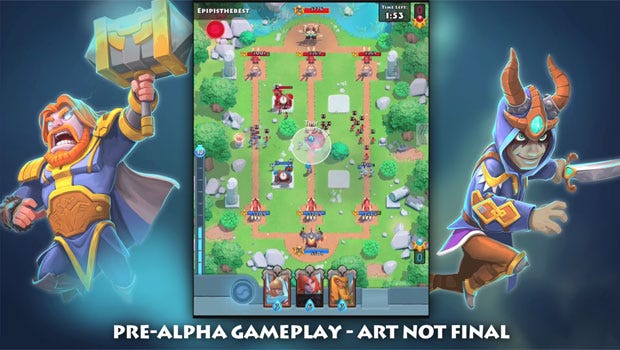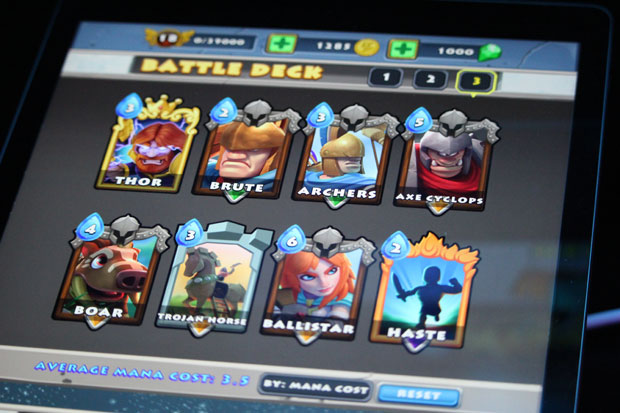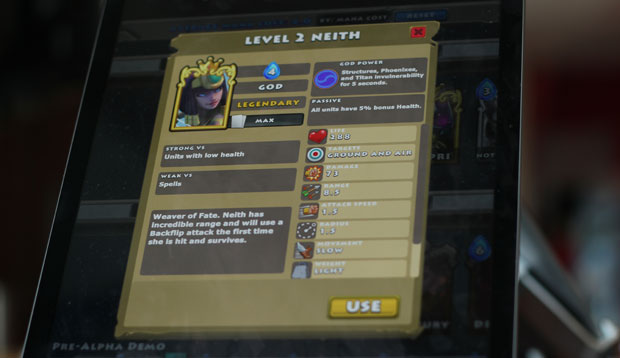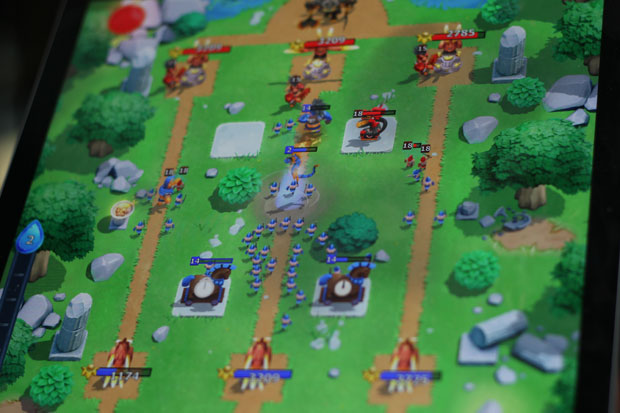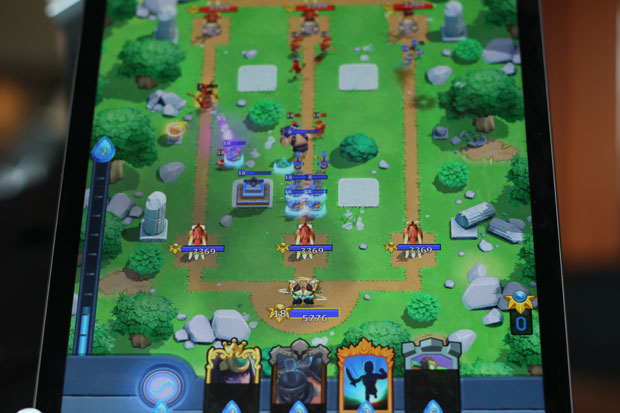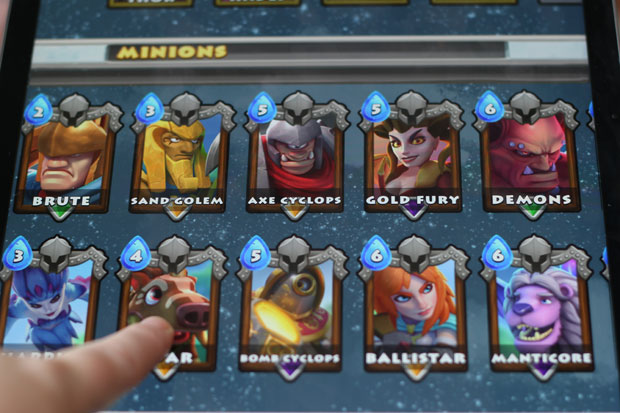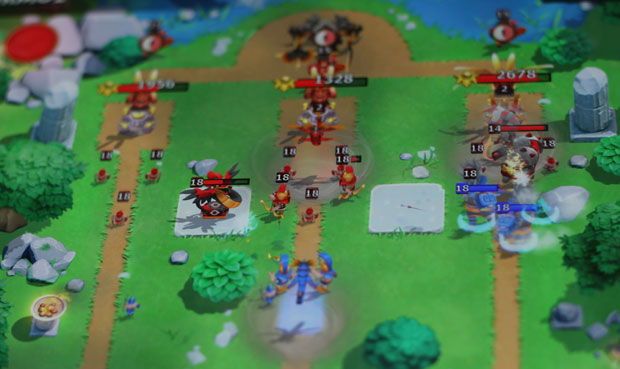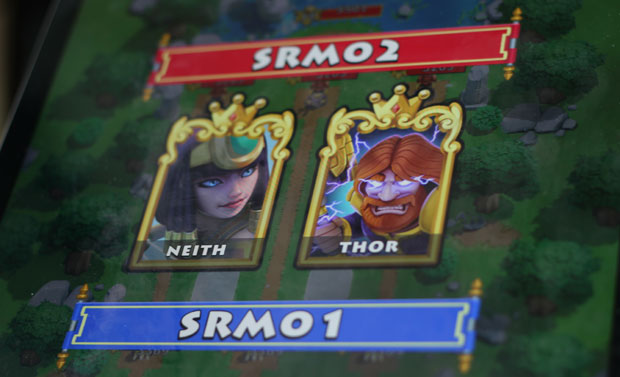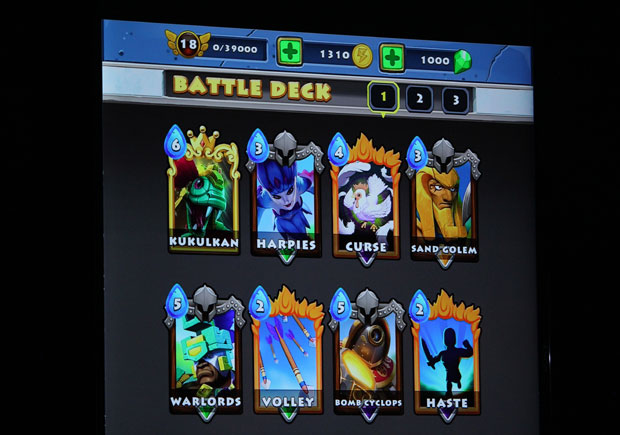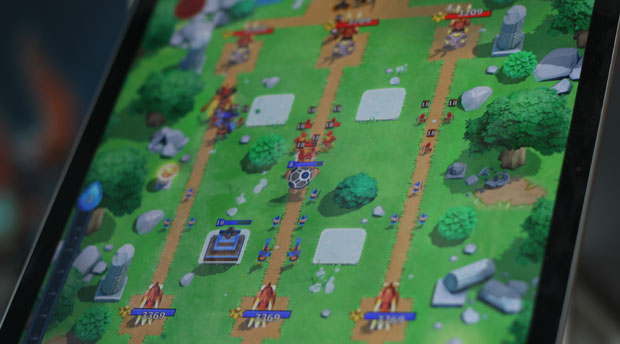Smite Rivals: how the god-themed card game works
Hi-Rez's god-based card game
Smite Rivals [official site] is the latest game from Hi-Rez Studios. It's being championed at the Hi-Rez Expo which is the company's annual esports-and-miscellaneous celebration of its games and community. People in baby pink, Rivals-branded tshirts wait by kiosks as curious attendees come over to play.
The game itself looks very familiar if you've ever played the mobile game, Clash Royale. It's a lane-pushing card game so you create a deck of eight cards to represent particular actions or units which will be available to you over the course of a few minutes and play those cards onto the three lanes of the arena as a pared-down real time strategy affair. The rate at which you can play cards is controlled by their mana cost which you pay from the mana bar on the left hand side which fills over time.
In terms of the game board, it's actually pretty similar to Smite's main competitive mode. There are three lanes in which you can spawn the units, each guarded by a phoenix. The ultimate objective – the titan – sits behind the phoenixes. You win by destroying more of these structures than your opponent. If you topple their titan that's an insta-win, otherwise the score is tallied once the time runs out.
One of the interesting riffs Rivals brings to this genre relates to how it uses the Smite gods as characters. You assign a god to each deck. The gods are strong units when deployed on the battlefield but they also have special abilities – one passive and an active ability which you can use by paying an extra mana cost. These lend themselves to different playstyles and you start factoring those elements into the deck you build.
As an example, I ended up gravitating towards Khepri decks. Khepri's special active ability is that you spend two mana points from your bar to reduce the cost of every card in your current hand by one. If you keep using that when it's off cooldown you can push down the cost of really expensive cards and play multiple high-powered cards later in the game when ordinarily that would have been far too expensive. That meant I was far happier to pop a Fire Giant - one of the expensive 7 mana cards - into this deck because I knew that I could probably reduce its cost over time and play it as part of a big wave of units rather than leaving it to trudge up the lane solo as I waited for the mana bar to recharge.
Neith offers a very different prospect as her passive ability grants a 5% bonus health boost to all units while her active ability makes your structures, phoenixes and the titan invulnerable for five seconds. The former can make squishier units more resilient and thus more viable, while the latter is useful for thwarting big waves of enemy minions because it buys you time to deal with them.
Neith in Smite is a ranged unit and her ultimate ability is a snipe shot she can fire off across an entire map. That's reflected in her Rivals character which can fire arrows from her current lane into any other. There's also a version of her Smite backflip ability in that the first non-lethal hit she takes triggers her to perform a backflip attack in lane. That's the current setup, anyway - the abilities and characters might well get wiggled around a bit as the game progresses and as people start figuring out builds.
I spoke to the game's lead developer, Brian Grayson, about Rivals. He actually used to be on Hi-Rez's legal and business development team, but became involved in the game development side. At the point where he needed to choose a focus he went with game development. Rivals has been in development for nine months, although the idea for a Smite mobile game is about nine months older than that.
Prototypes for an RPG and a match-three Smite game followed but they settled on what Grayson refers to as a "tug of war" game, which is essentially another way to describe trying to out-pressure your opponent in terms of the lanes, although it's more about pushing than pulling. After that it was just a process of figuring out the exact format, which Hi-Rez refer to as a collectible card arena game.
In terms of Rivals' unique selling points Grayson picks out the role of gods and how that influences how decks work because of how their strengths and weaknesses lend themselves to particular playstyles or card synergies.
Combat is the other point of difference: "The way you play cards in our game is you pick one of the three lanes you want to play the card in and for a lot of the cards – for minions in particular and spells – that's it. The minions will spawn at your phoenix. There's no positional placing, they just spawn there and march down the lane. Where you get a lot of the depth in our game is the cards you choose to play and what lane you choose to play them in."
The structures you can place which generate units are similarly limited as you only have two free spots to plant them in. Given all that, you need to keep in mind the strengths and weaknesses of the units and the timings with which you spawn them. You can't suddenly realise you need a ranged unit to go ahead of a tanky unit and just plonk it into position on the lane.
You also need to pay attention to a unit's special skills. Archers can attack ground and air units but their range also means they can fire arrows into adjacent lanes. That means putting the archer card into the middle lane could theoretically help you cover all your lanes. The extended info you get when you click on units in the deck building screen will also give you an overview of their strengths and weaknesses which should help when you're starting out, though.
I ask about the Clash Royale similarities, because when confronted with Rivals, Clash Royale is the instant reference point. The two look incredibly similar at first glance and I don't think there's any getting away from that.
"A lot of the comparison there comes from the camera angle, the art style and card collection style we chose. People see those and they draw that comparison pretty quickly," says Grayson. For me it's the art style particularly as well as core elements of the UI. At one point in the interview Grayson describes why Rivals ended up with the art direction it did, particularly in view of how games tend to treat gods from mythology:
"What if we did the cutesy version of these characters? You look at all the traditional games across the industry and you'll see these games where there's these awesome, muscular, powerful characters and then you go to their merch and the first merch item is the plush version or the cutesy figurine."
The piece of Smite merch I see people clutching here is a case in point – a plush, cutesy version of the snarling, slavering Fenrir. That plush actually sold out during the show. I don't have any reason to doubt what Grayson says but Rivals feels emblematic of a reputation problem which seems to come with Hi-Rez games – that of being seen to tread too far into another game's territory in a way that onlookers feel is cynical or wrong.
It's not something that seems to get much mention amongst fans of Hi-Rez's games and, in the case of the games I have played of theirs, that feeling of déjà vu dissipates once you feel out the mechanical differences through play. But it can be a real stumbling block in terms of introducing their games to new people or garnering goodwill from the wider gaming community.
Given it feels like an issue that doesn't just apply to Rivals, I brought it up in an interview with Hi-Rez's president, Stew Chisam.
"Interestingly I don't mind those questions at all. I think everyone needs an anchor point to understand what you're trying to do. When you see a new movie you tell people it's kind of like this movie but with this thing. I don't think you have to run away from that in any way and we do have solid answers as to how [our games are] different."
He goes on to point to a difference between retail products and free-to-play in terms of the company approach: "The comparisons I think when you have a free game are very different. People get in the retail mindset. If I'm looking at two retail titles that are both team-based shooters and I'm like, 'I only want to spend $60 once,' you have to orient your marketing to really drive people to understand those differentiating points.
"When you're a free title what you want to do is get people to play it and make their own decision around was that special enough that I'll hang around? We don't get paid unless someone plays our game and likes it and found it different enough to keep playing our game versus the competition.
"To us it's not bad. If you're a fan of Clash Royale try Smite Rivals and decide whether the changes we made in that collectible card arena genre advance the genre in a way you enjoy or not."
I think this might be conflating two issues. People do look for reference points and ways to explain new games to each other using existing or familiar games, but there is a difference between the players or the media doing that and the company itself actively providing the reference or potentially using that other game's familiarity as a foot in the door with consumers.
He adds, "In the early days of Smite, Twitch chat in 2013 of Smite was 'League of Legends copy!' You look at it like, 'REALLY?!' But enough people tried it and found something different and we found our own niche and our own community. Paladins has had to get over the 'Hey, TF2 copy!' or 'Overwatch copy!' or all of those types of comparison. Now people try it and they make their own judgements. We find the people that really love what we did and was unique and we keep them. That's a long answer to say I don't spend a long time worrying about it!"
I'd agree about Smite – it's a very different prospect to League of Legends and I think it probably suffered from the fact that the MOBA genre wasn't really a genre so much as a two party system at that point. There were third-party candidates in the form of Heroes of Newerth and so on, but it wasn't a space where variation in the formats was treated as creating a significantly different product yet.
Paladins is similar – it took a bit of time to find its feet but certainly in the current format it's a meaningfully different prospect to Overwatch. I think you pick that up quickly if you watch a match or play it yourself, even though the art style, existence of particular champion abilities in combination with particular characters, and camera angles do still very much invite the comparison. I think there's an element here of smaller genres or more compact gamespaces being mined out for significant differences. This approach can yield new options for fans of that space but it's also a problem because, regardless of whether the game is eventually judged to be unique or a copycat, the company will look like they're piggybacking on someone else's success.
As a follow-up I ask what happens when you don't have an interview or a Reddit AMA in which to defend that way of thinking or answer to those criticisms. Is Chisam concerned that this will damage how people think of Hi-Rez?
"Up to a pivot point, yes," he says. "It's a big gamble on our side."
The gamble Hi-Rez are making is that a game will attract a strong initial core community and then having those people's enthusiasm become part of spreading the message that the game is different and worth trying. "We focus on finding those people first and then either we made a game that stood on its own and could do that or we didn't," says Chisam.
Of the general criticisms of Hi-Rez's approach he says, "initially I think it is a barrier because people will dismiss your game and not try it unless you necessarily got all those messages out clearly. Because we tend to release our games earlier maybe than a lot of studios and iterate a lot and drive to the highest polish level after people have initially seen it, it takes time for those messages to sink in."
Paladins is an example of this kind of evangelism. "With Paladins we spent almost a year in closed beta and our number one focus was 'Let's find a good, strong core community that, when those comparisons are being made, they will defend us.
"That has largely happened. That doesn't say there aren't still people that only get the highest level association but our bet is over time that evangelist will convince someone who will convince someone who will convince someone… and it will eventually get to that person. 'You really should try this, it's not what you think – this is anything but a company that just clone games.'"
Chisam also feels very strongly that the games do stand on their own as products. "I think everything we do does put a unique spin on the genre that we enter. Most people who really get into and play our games figure that out and we rely on great word of mouth to do that. At the end of the day that comes from faith in what you're building.
"If we had less faith in what we were building we would probably build a marketing strategy that worried a lot more about that. But because we have so much faith in what we're building and because we're free the barrier to try and make your own judgement we believe in mostly focusing on the community and letting that community be evangelists who educate and defend you."
I've been thinking about this a lot since that interview and I've revisited both Rivals and Clash Royale. I'm trying to hammer out why exactly I'm not at ease with the situation and the response. I think my discomfort with Chisam's response is partly because of the onus it places on fans to have to defend something they enjoy. That's never fun.
I absolutely love medical soap operas and hidden object adventures but snide remarks from people who don't or who think they're cheap or derivative can really be an irritant. I feel like Hi-Rez create a situation where, yes, you might get an evangelist, but you might also get someone who is sick of defending something and stops talking about it – at least to the wider gaming community. To put it another way, it's a decision on the part of a studio which can potentially become a cost to the player.
When it comes to Rivals I do think that the game plays significantly differently and it scratches a different itch to Clash Royale. I really like the addition of the gods to the decks and making it so the units only spawn at one point in the lane means a different kind of tactical thinking is required. I have that urge to figure out deck builds and make characters I'm fond of "work", even though I've led them to some hideous defeats at the Hi-Rez Expo.
But I also find myself thinking "Why didn't you go cutesy but in a different way so this wasn't even a question?" It bothers me that, when I feel a game can stand on its own mechanically, the other choices seem to actively get in the way of that success. Or at least require me to keep pointing out differences.
At this point I will say that I'm definitely approaching the situation as a PC-focused person. I can't speak to how it feels or comes across to mobile players, nor can I speak to the business benefit of getting people through the door of free-to-play with something they recognise versus the impact of the reputational hit as I don't have access to those metrics.
But let's get back to Rivals itself.
One of the concerns I have when it comes to deck-building games of any kind is that they become solved problems. Sure you can make your own deck if you want to but there will be THE list which someone has figured out and which, if you want to win reliably, you will always play.
"I'm almost positive that will happen," says Grayson. "It's a cool thing – it happens in traditional Smite too with item builds. People who are very into theorycrafting will come up with these great card builds that will become the meta.
"What ends up happening organically over time in the games I've observed is that actually, sometimes with the developers' touch but a lot of times without, somebody will be so determined to be the one who doesn't play into the meta that they will break the meta with a combination of cards that are already in existence."
He's hoping that this happens with Smite Rivals. There will be some balancing, but the breaking apart of a meta would come from the players themselves and the addition of new gods and new cards. That's the other thing. Grayson adds that Rivals should expect an aggressive content cycle, so at least one new god a month and probably other cards to accompany them.
The plan is to have the game available as a cross platform project (Apple's App store and Google Play for mobile and Steam for PC – not the Hi-Rez launcher, at least to start with). You can sign in to the same account on mobile or PC and pick up where you left off.
There is likely to be a period of early access on PC but not on mobile – partly because of how mobile distribution works and partly because of how mobile audiences approach games differently. The earlier PC access would help with feedback and server testing. The overall plan is to keep the audiences combined, though they will evaluate feature suggestions as they come in.
The game is a lot further along in terms of production than the demo build would suggest – a lot has been deactivated for the sake of being able to show people the game in a show floor setting. The team are also still playing with units, legibility within the game and so on. Based on my own play, I'd really like to see the deck-building screen streamlined a bit because the detailed information on what cards do is currently hidden behind two clicks or screen taps and it feels like it should just be one. There are also a few points where I know I didn't understand an event due to the visual cues seeming unclear - I think there was a slow effect that I was reading as haste, for example.
There's a curious tease when I ask about monetisation and how the team are going to avoid pay-to-win situations. Grayson talks about a mysterious idea Hi-Rez have been working on: "I think it's not just something cool for our project but I think it's going to be something cool for the industry as a whole that's really going to push forward what people can do in free-to-play but I'm not allowed to talk about it yet."
What else? A campaign mode, perhaps?
He responds, "There's a lot we'd like to do there. It's too early for us in the game's life cycle to commit to those kinds of things. What I can tell you will be there is your ability to play against the AI and the AI is very good. It's so good we're not letting people play against it on the demo because the designer went to above and beyond that I played it and I barely drew against it!"
More broadly, the response at the Expo seems to have been good. I've gone past the booths a few times between esports matches and people have been playing, figuring the cards out and taking one another on for more than one game. My interview with Grayson took place on the second day of the Expo and when I asked how it was going he grinned: "Today has been cool because a lot of the people who were there day one have come back and are trying to figure out card combinations."
That's a real positive, and it's a pull I've felt myself. I want to sit down and really figure out the card combinations for favourite gods. I want to tinker with the cards and structures greyed out in the demo build to find out what they do. I find myself a little frustrated that it'll be a while longer before I can do any of that when the Expo ends. That's all really promising. I just don't relish the prospect of needing to respond to Clash Royale comparisons as part of playing.
